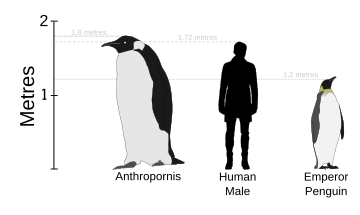Anthropornis
Anthropornis is a genus of giant penguin that lived 45-33 million years ago, during the Late Eocene and the earliest part of the Oligocene.[1] It reached 1.8 m (5 ft 11 in) in height and 90 kg (200 lb) in weight. Fossils of it have been found in the La Meseta Formation on Seymour Island off the coast of Antarctica and in New Zealand. By comparison, the largest modern penguin species, the emperor penguin, is just 1.2 m (3 ft 11 in) tall.
| Anthropornis | |
|---|---|
| Scientific classification | |
| Kingdom: | Animalia |
| Phylum: | Chordata |
| Class: | Aves |
| Order: | Sphenisciformes |
| Family: | Spheniscidae |
| Subfamily: | †Palaeeudyptinae |
| Genus: | †Anthropornis Wiman, 1905 |
| Species | |
| |
The type species, Anthropornis nordenskjoldi, had a bent joint in the wing, probably a carryover from flying ancestors.

An Anthropornis penguin in comparison to the height of an average human male at 1.72 meters (5 ft 7 1⁄2 in) tall and an Emperor Penguin at 1.2 meters tall. The Anthropornis is based on Emperor penguin dimensions.
References
- Myrcha, A., Jadwiszczak, P., Tambussi, C.P., Noriega, J.I., Gazdzicki, A., Tatur, A., and Valle, R.A. (2002). "Taxonomic Revision of Eocene Antarctic Penguins Based on Tarsometatarsal Morphology". Polish Polar Research, 23(1): 5-46
This article is issued from Wikipedia. The text is licensed under Creative Commons - Attribution - Sharealike. Additional terms may apply for the media files.